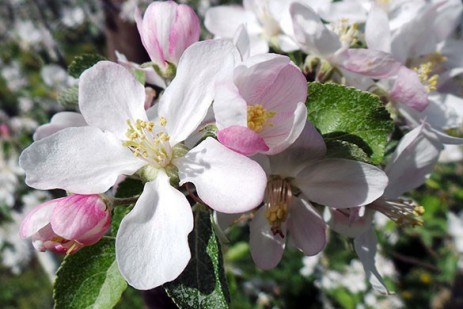May 5, 2020Penn State: Use caution when considering 2020 early fruit thinning strategies
Cold temperatures centered on April 17, 2020, may have caused widespread injury to developing apple flowers.
In southern regions of Pennsylvania, where flower development was at pink to early bloom, injury was evident as death and was apparent by browning of the ovules.
Damaged apple flowers, left and center, and a live flower, right, from April 17, 2020. Note browning of the ovules on left and center flowers. Photo: Melanie Schupp, Penn State
In more northern regions the flower clusters were at tight cluster to early pink when the freeze occurred. In this case, the injury is evident as browning of the pistil, especially in the center blossoms in the flower cluster. These blossoms were the furthest advanced in development.
April 2016 freeze event: Apple flower buds were assessed for visible injury to the pistil. Blossoms with a healthy pistil were rated as viable (A). Injured blossoms exhibited pistils that were brown and desiccated (B). These blossoms were rated as dead. Photo: Tom Kon, North Carolina State University and Edwin Winzeler, Penn State University
Slower developing side blossoms in the cluster appear to be less damaged or undamaged. These forms of injury may have an impact on crop potential and should be carefully evaluated before any further crop load adjustment, especially chemical thinning, is attempted.
The first step is to check for damage in the orchard. If there is evidence of brown pistils or ovules, then caution is advised. One concern is focused on blossom thinning with the Pollen Tube Growth Model . This model is designed to retain the blossoms that open first and prevent later blossoms from being fertilized. In some orchards, the first blossoms may be incapable of being fertilized and the potential 2020 crop will come from the later blossoms that blossom thinning is designed to eliminate.
A second concern is thinning at petal fall when a portion of the flowers is damaged by cold. Damaged flowers may persist until well after petal fall, especially when the weather stays cool as is forecasted for the coming week. Fruits that are destined to die may remain on the tree until 7- or 8-mm fruit diameter.
If you see evidence of flower damage it is suggested that you wait until the fruits have grown to 10-12 mm in diameter before deciding if you need to thin this year. The April freeze may have done some or all your thinning for you and this may not be evident until the surviving fruits have had an opportunity to grow.
Apple flower split longitudinally and diagrammed to show its parts. (MacDaniels and Heinicke, 1929)
– James Schupp, professor of pomology, Penn State University
Photo at top: Apple blossoms. Photo: Rob Crassweller


















